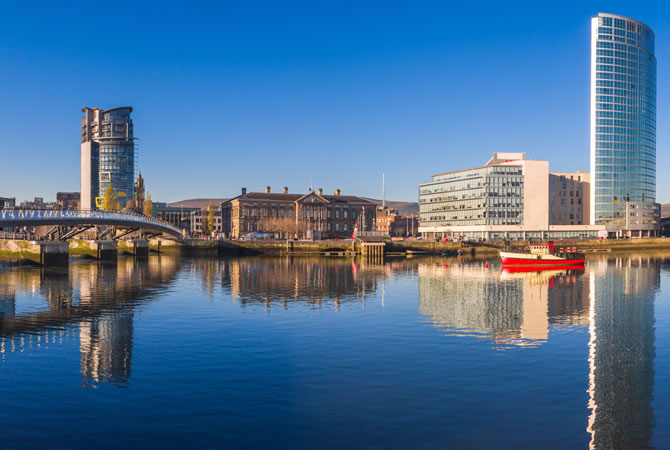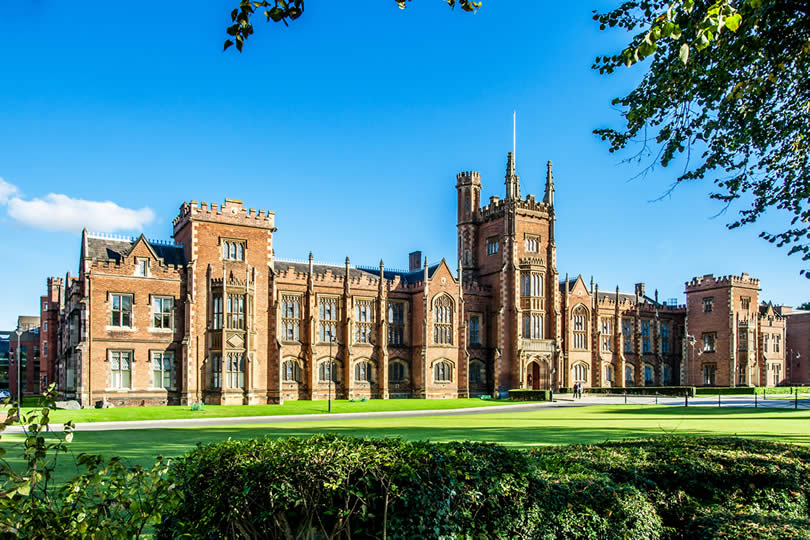Belfast Travel Guide
Belfast Northern Ireland
Belfast is the largest city in Northern Ireland, steeped in history and with its origins in the Bronze Age. In the Middle Ages, John de Courcy marked its importance by building a small castle in its centre. Although the original castle is no longer there, Belfast became a location of political events, including conflict.
However, the city has emerged from its troubled past and transformed into the beautiful place that it is today. It is filled with parks and gardens, riverside walks and landmark buildings, which you can enjoy for free, in addition to cultural and sporting events.
How to get there
Surrounded by sea, mountains and lakes, Belfast is situated in County Antrim at the mouth of the Lagan River, which flows into the sea inlet of Belfast Lough. This location makes ferry travel to Belfast amenable, with crossing routes from Liverpool in England, and from Stranraer and Cairnryan in Scotland. Visitors from Great Britain can avail of Saltrail, a combined ferry and rail ticket offer that operates from a number of UK cities.
Two airports
Belfast International and the George Best City Airport serve the town. Planes from major UK cities fly into both airports daily. Belfast International, the larger of the two, has connections to a wide range of world cities.
Rail and Bus
The Ulsterbus network operates commuter services to other areas of Northern Ireland. Rail and bus links are in place between Belfast and the Irish Republic, several of these connecting with Dublin.
When to go
The Belfast climate is moderate, averaging 5 degrees in January and 15 degrees in July. However, you may want to avoid the summer crowds by travelling during the spring and the autumn.
If you wish to attend a particular sporting or cultural event, such as the Cathedral Quarter Arts Festival, book in advance to get the best price. Check online for travel firms that offer discounted accommodation and ticket deals to visitors attending these events.
What to see
Belfast was originally a market town, which expanded rapidly during the 1800’s. Donegall Square is at the centre – and the heart – of Belfast. Named after the prominent Donegall family, it is the financial quarter and notable buildings here include the City Hall and the historic Ten Square Hotel.
North of the Square is the Cathedral Quarter, and is the location of Belfast’s oldest buildings and streets. The annual Cathedral Quarter Arts Festival takes place here. Hosting international performers, this festival of music and comedy happens in late April and early May. Visitors are welcome at St. Anne’s Church of Ireland Cathedral.
You pay a small admission charge to see the treasures inside this century-old building, like the beautiful mosaic Baptistery. At night, the cathedral’s 40-metre Spire of Hope is illuminated, and has become a Belfast landmark.
South of Donegall Square is the Queen’s Quarter, the location of Queen’s University. On nearby Stranmills Road is Belfast’s Botanic Gardens. Its attractions include the Palm House Conservatory, which has opening restrictions. The unique Tropical Ravine House features a ravine running its length and has a viewing balcony on each side. Outside of the plant houses, do not miss seeing the extensive herbaceous border, the rose garden and several species of tree. The Gardens are open to the public all year round and host several concerts and music festivals.
Located in its grounds is the Ulster Museum, the largest museum in Northern Ireland. Recently reopened following extensive renovations, visitors can see collections of fine art, and archaeological and ethnographical artefacts. Admission is free and it is open from 10 am to 5 pm, Tuesday to Sunday. It is closed on Mondays, except on Bank holidays.
North-east of the Cathedral Quarter is the Titanic Quarter, a large-scale waterfront development that includes film studios, entertainment and maritime landmarks, the most famous being the Titanic Park. This development marks the site of the former Harland & Wolff shipyard, where the ill-fated Titanic was built. The Titanic Quarter building is open daily to the public and hosts exhibitions concerning the ship’s history. Translink metro services connect the Quarter with the centre of Belfast.
Where to eat
Belfast is filled with cafes and restaurants with prices to suit every budget and every taste. However, the top-rated restaurants are situated in the Cathedral Quarter, and include Made in Belfast (Talbot Street), The Muddlers Club (Warehouse Lane) and the Coppi Restaurant (St. Anne’s Square). Aficionados of fresh food should not miss St. George’s Market, where you can shop for fruit and vegetables, clothes, books and antiques.
The Saturday market hosts vendors of craft goods. It takes place on East Bridge Street and you can get there on a free shuttle bus departing from Royal Avenue, in the city centre. It runs every twenty minutes, from 11 am to 3 pm, on Fridays and Saturdays. To enjoy serious – and fun-filled – drinking, go to the John Hewitt bar for example at 51 Donegall Street. It is open from 11.30 am until 1 am, and in addition to the pints, visitors will enjoy a constant round of live music acts.
Where to stay and how to get around
Extensive road networks make Belfast suitable for motoring, important if you are staying outside of the main part of the city. Accommodation options range from budget hostels, bed & breakfasts and hotels.
The most expensive accommodation is in the city centre, but even within this area, a range of options is available. Special offers may be available at certain times of the year and you can check online for news of these. If you are motoring, do check out the hotel parking facilities. Within the city, Translink operates a network of suburban train and bus services.




